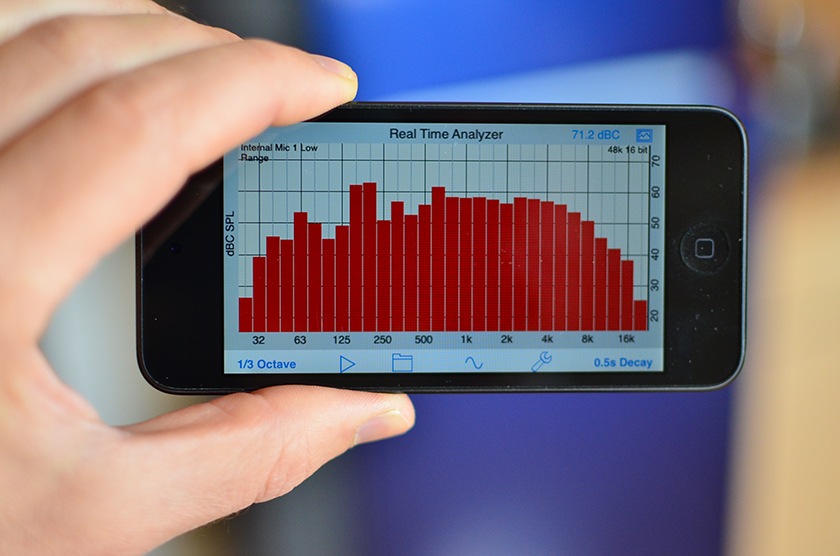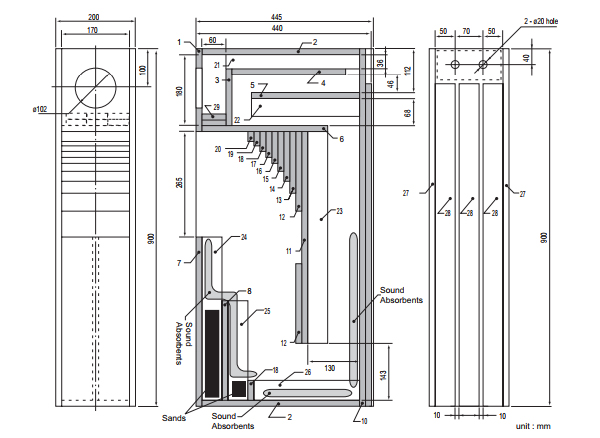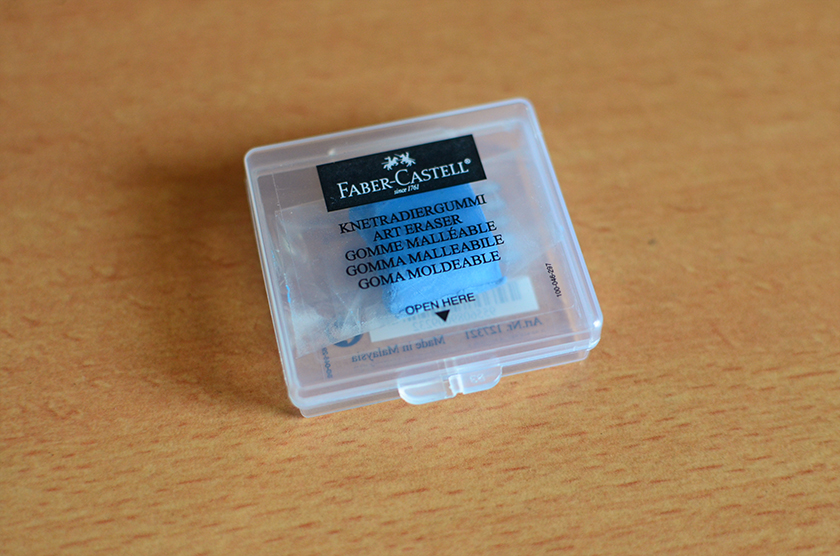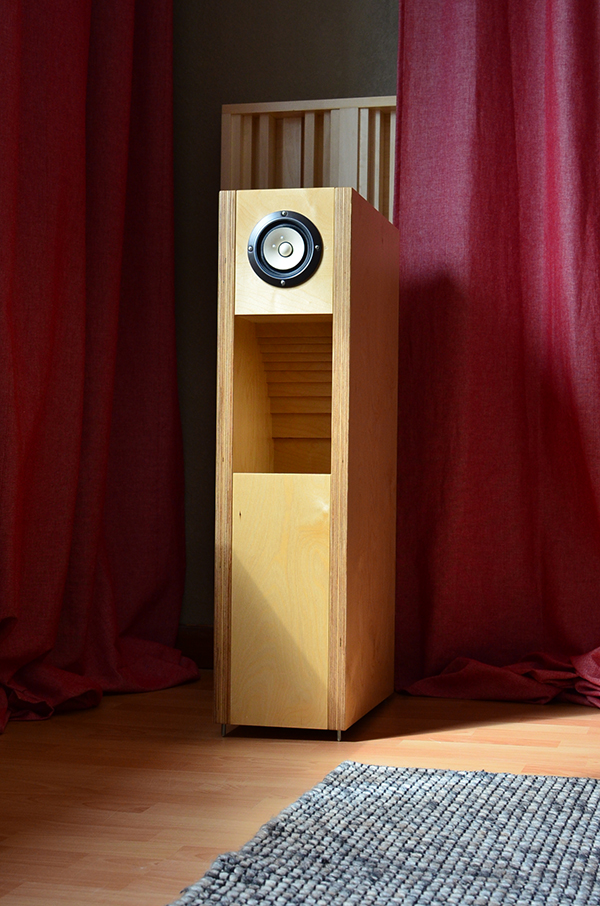Some time has passed since Fostex FE108-Sol drivers took the place of the former Sigma model in my back-loaded horn enclosures and I had enough time to experiment further with them. As mentioned earlier the disposal of the notch filters, necessary for linearization of the frequency response of the Sigmas, brought a great deal of refinement. I realized how destructively the combination of resistor, capacitor and inductor on the signal path could act and from the perspective of time I can say – there is no way back to use them.
Though the frequency response of the FE108-Sol is way more linear it is still not as flat as I would like. Still there is a hump of approximately 3 decibels in the midrange between 800 Hz and 4 kHz but I am decided not to exchange their impeccable timing and immediacy for a flat and accurate tonal balance.

What I learned by going through this experience is that one could not have both, at least with this type of speakers, but have to decide either to enjoy their innate virtue of depicting events in the most immediate and direct way by revealing the presence of life in the record or to preserve his comfort zone by flattening out the response thus not allowing the upper midrange to intrude into it, but draining out part of the life and the atmosphere captured in the record.
Touching the signal for frequency linearization purposes will always lead to degradation, and even if it is comparatively small, it will still be detectable. Doesn’t matter if the correction is done in digital or analog domain – any attempt of equalization will leave its traces, however minute they are. In the digital domain quantization noise is unavoidable (DSP correction). Any analog correction that routes the signal through additional passive or active electronic components is prone to induce noise by phase shifts and energy loss as well. In this respect I would say I am a purist and though all these techniques might be useful and even necessary for certain types of speakers I doubt one could tame back-loaded folded horn speaker without bringing serious damage to one of its most precious virtues – to reveal the drama entangled in the music.
Sure folded horn designs have their weaknesses not only in the amplitude domain (frequency response) but also in the time domain, related to the decay time of the signals along the frequency spectrum, reflected in the so called decay time waterfall graphs. Such decay time related unevenness is the main reason for the presence of the so called box colorations of the sound, which can seriously damage the fidelity of an audio system. Apart from the driver specifications such decay time related issues depend entirely on mechanical factors like enclosure stiffness and resonant behavior, but also on the type of the damping material, its quantity and distribution. In this respect Günter Damde’s decision to double the thickness of enclosure’s side panels from 1,5 centimeters, as conceived originally by Fostex, to 3 centimeters in the Art of Sound‘s version of BK108 is a positive development.

I appreciate Damde’s puristic approach in regard of the damping material as well, which Fostex engineers leave open for the user to decide according to his preferences and tastes. Damde use self adhesive damping mat of 1 centimeter thickness to tackle internal standing waves at the back side of the compression chamber and along the bottom (horizontal section), respectively back (vertical section) side of the horn throat until it reaches the bottom of the cabinet.
I spent quite some time playing with different types of damping materials like wool or foam in the compression chamber and in the horn mouth, but after all these trials I have stuck to what Günter Damde set initially. The design of these speakers is such that if one decides to bring additional damping he could reduce the decay time related fidelity degradation but in the expense of loosing some of the finest low level details that contribute greatly to the spectacular live-like presence of the reproduction these speakers are keen to deliver.
So one have a choice to adjust the speaker’s output according to his preferences. Especially when foam based damping like Tyrotex Wiffle-Foam is used in the horn mouth and polyester or wool felt in the compression chamber these speakers sound pretty much like ported box designs and let say typically HiFi – the bass becomes dryer and tauter, middles become cleaner and the soundstage feels deeper, but as I said all this has its price – the presentation is robbed of its most precious gem – the liveliness.
The phenomenon of liveliness a record bears is locked in the low level details and fine nuances within the complex harmonic structure that all the additional damping tends to harm. So in relation to damping quantity my opinion is that less is actually more.
One have also the opportunity to use sand to additionally damp resonances by pouring it into the pockets just below the mouth opening. Though such intervention will reduce the internal volume of the cabinet and thus will shift the harmonic structure upwards it could additionally boost the clarity, detail resolution and a sense of weight in the low registers. I used to have them pockets filled in to one third of their height with sand but after decoupling the cabinets from the floor properly there was no need of it anymore.
The good thing about all these adjustment possibilities is that one can tailor to certain extend the presentation to his own taste. Generally speaking the HiFi approach (using more damping) will benefit much broader spectrum of recordings and musical styles so that even not very well recorded music will sound acceptable. The damping-less approach in opposite will make bad and very bright recordings almost unbearable, but if you are type of timbral listener and have plenty of natural and live recordings in your library you’ll benefit with directness and transparency that convey the atmosphere in its full glory.

While listening to José Feliciano’s Alive Alive-O! performance I found myself amid the audience in the hall, forgotten entirely about any gear related stuff. There were no speakers, no amplifier or digital processor – just the singer, his guitar and the shacking crowd. Good acoustic studio recordings like Kerstin Bloodig’s album Trollsang, though not as spectacular, sound not bad at all. One still feels connected but this time with the studio. Every detail is presented – the successive strokes of the pick along each individual string of the guitar, her voice, soothing and warm gives clues where exactly the microphones have been placed. One can even imagine the recording engineer behind the glass wall bent over the recording console while performing his routine.
But don’t get me wrong – these speakers are not studio monitors and as I said when not sufficiently stuffed with damping material they are not free of colorations. In the frequency response graph there is a quite unpleasant peak in the upper bass region at around 160 Hz which combined with decay time related imperfections in the low frequency region contributes for appearance of specific enclosure related colorations, which in the case of Kerstin’s album make her guitar sounds a bit weird in the low octaves. One have the feeling, especially when fifth and sixth strings are strummed, that the guitar has somehow bigger body and different shape. I can imagine some mixture of western acoustic guitar and Persian oud.

Checking the song Bergtatt with my Beyerdynamics DT 880 Pro confirms that notion. In reality she uses a standard six string western acoustic guitar which in the studio, though close miked, have all the conditions to sound natural and unspiced of any hall reverberations. These are anomalies that folded back-loaded horn designs usually tend to expose in certain amounts. At the end these slight deviations in the upper bass tonal balance do not harm the overall harmonic structure and the atmosphere of the event is there with all its palpability. The sense of weight of the instruments, spatial information, dynamic contrast and timbral nuances are such that one forgets himself completely in the music, something which DT 880 Pro fails to achieve. Knock on the guitar’s soundboard is as vivid as it happens just between the speakers and with eyes closed one can hardly put it into doubt.
Apart of the damping I stumbled upon another important factor, which plays a crucial role in the performance quality of these speakers – the mounting of the drivers. I was using still the old Sigma drivers when I decided to mount them by means of threaded inserts. It was necessary because the frequent mounting procedure, I performed often to test the impact of different damping materials on the sound, has already worn out the screw holes so that it was impossible to tighten them properly.
Back then I didn’t pay any attention to the sound outcome of this switch, it was just way more convenient to be able to unmount the drivers without the threat of destructing the fragile threads carved inside the multiplex front baffle. After installing the new FE108-Sol drivers it somehow occurred to me that a different torque force applied to the bolts gains very different sonic results. It was easier to distinguish now because the M4 bolts were way more efficient than wood screws when screwed with equal torque force. It became obvious that low torque elicits better results. By applying high torque force the soundstage has shrunk and stepped few meters aback, the dynamic contrast got reduced and the whole presentation felt somehow restraint. I reached the conclusion that these full-range drivers just need freedom to sing.

Considering the fact that by introducing threaded inserts the coupling between driver and baffle is way more secure compared to the wood screws I decided to check both solutions against sonic differences with respective torque strengths. I turned the drivers 20 degrees clockwise and screwed them directly into the baffle. Now since I was aware and listened for changes it became apparent that when coupled with wood screws these drivers sounded quite dull. Though I tried different torque strength compensating for the bigger resistance, a thread with larger step have, it was obvious – when mounted with wood screws they sounded unspectacular and cheap.
Introducing threaded inserts as a mechanism to reinforce the coupling between driver and baffle resulted in quite spectacular improvements along all the aspects of the reproduction. As I said bolts don’t need to be screwed tightly, just the opposite – they require very low torque so that the gasket between drivers and baffle can absorb the resonant energy of the driver thus preventing this mechanical energy to bounce back and affect its performance. What I think the bolts actually did is to hard cut the forward movements of the driver so that it could bounce forth and back in certain limited range. What matters here is that implementing threaded inserts with bolts brings as a result an improved security by decreasing the tolerance of permitted forth/back excursions of the driver.
The gaskets were already overused being thin as a sheet of paper so I needed replacement to further continue this experiment. I decided to try some putty material like Bostik’s Blu Tack prized by many as DIY alternative to the standard foam tape solutions. Michael Methe’s latest Audio Note AN-E speakers project is not an exception and many do-it-yourselfers prefer putty type of material to the standard neoprene foams. I ordered a package of Blu Tack, but being impatient I tried first regular putty eraser which I had at disposal.

It is very much the same type of sticky material with slight elastic qualities, but as it turned out softer than Bostick’s solution. Already with this type of putty rubber I had rather satisfying results and experimented further with different thickness, though because of its softness it did not allow me to form more that half a millimeter thick gasket layer. In the opposite when the ordered package of Blu Tack arrived I realized that although it might serve pretty well bigger drivers (8 inch and above) it was too stiff to be used exclusively with these 4 inch drivers.
I tried several compositions of Blu Tack and putty eraser and at the end I settled with composition made of equal parts Blu Tack and putty eraser for creating a gasket of 0.73 millimeters thickness, which yielded quite amazing results. Before the bolts have been tightened I placed a set of four 0.73 millimeters thick guitar picks between the driver and the baffle to set the gasket thickness.

After the drivers have been tightened these picks were removed, the overflowed putty cleared out and the bolts loosened a bit. It was quite interesting to observe how the overall sound picture changes in accordance to the torque strength applied to the bolts. Because the gasket was now made of a sticky material it was possible to remove the the bolts completely, something I did in order to asses what their exact contribution was, even when they were screwed pretty loosely. Without them, though quite large, the presentation lost focus and suffered in all its aspects. Once I screwed the bolts very loosely so that they can not compress the gasket further but just restrain the forward driver excursions the impact on the reproduced music was nothing but tremendous.

I was happy because this very important point – the interface between the driver and front baffle where unwanted resonances may occur – have been sorted out.
As the first problematic resonant prone point was addressed I became aware of the second one – the interface between the speakers and the floor. I ignored it for a long time because all of my previous attempts to decouple them using spikes have failed miserably. This I could explain with the use of protective disks underneath the spikes, which according to my experience is compromising heavily the decoupling effects the spikes are meant for, especially when used on wooden or laminated floors. After the discovery of the grub screws in a nearby hardware store, which in spite of having conical ends were not as sharp as to punch through the floor covering, I bought eight short pieces of 1 centimeter length just for the sake of trying them underneath the four corners of the speakers. I fixed them temporarily with the means of small balls of Blu Tack.

Giving them a go with the song “Vete de mi” from Enzo Pietropaoli’s DOS in Sight album my jaw dropped – such a tremendous gain on clarity, weight and separation I haven’t expected. The slams of the double bass appeared from the black background expanding further beyond the speakers with power and density unheard before, and Eleonora Bianchini’s voice, soft and mellow, was infused with humanity and visceral presence. Next I played Vicente Amigo’s “Sevilla” from his album Memoria de los Sentidos where his knocks on the sound board of his flamenco guitar and extremely fast rasgueados were transmitted with clarity and naturalness I haven’t heard before. I bought 6 centimeters long M8 grub screws and with the help of a cap nut screwed them directly at the bottom ends of the cabinet’s side panels adjusting them so that the speakers were slightly tilted backwards in order to aim the driver’s axes at the level required from the listening position.

Installing Fostex FE108-Sol properly and decoupling the enclosures from the floor made these speakers perform on an entirely new level I was not prepared for. The clarity is such that now I can discern more easily the typical horn colorations in the upper bass region and the slightly more pronounced midrange I mentioned earlier. But these trade offs are compensated by their ability to reproduce the atmosphere of naturally recorded audio acts in a way fewer can do.
At the end having such speakers might be seen as a struggle or a joy – it depends on the perspective – for me it is fun and a great opportunity to learn something about the audio reproduction by getting involved with adjustment and customization of its final link – the speaker. Checking out how particular driver in certain conditions performs, observing the influence that different damping materials cause on the reproduction is an eye/ear opener. With the most out-of-the-box speakers one is very much limited in learning the nature of the sound. The other thing is that solving problems by trial and error could greatly contribute for establishing criteria for distinguishing between true and false, which in the scope of audio reproduction are rather hard to define. Someone might say: “Hey, it is a matter of taste – there is no objective truth as long as judgments are based on subjective perceptions!”. I would say there is truth that has been captured on location by means of microphones and other electronic components when the record has been made.
Some people claim that along the acoustic waves also the atmosphere is being captured somehow, and I am inclined to believe this. Apart from the intelligible layers of musical content (the music itself: melody, harmony, rhythm, tone, timbre, etc) and sonic content (recording artifacts like soundstaging, imaging, transparency, etc.) there is a layer of information related to the performance itself that constitutes the so called atmosphere. This layer I suppose finds its way in the finest nuances and low level details that our brain unconsciously process when available. What I think is the main virtue of these speakers is their ability to reveal this sub layer of information that a record has – the atmosphere of the event, which under certain conditions could act as a catalyst for connecting listener and performer and thus transforming the listening act to an emotionally matured and satisfying experience.
I hope some of these observations prove helpful for you, happy listening!


Thank you for your interesting posts. It is really inspiring.
I have just started to build a pair of BK108 enclosures, as a winter project. But I have a question regarding one of the items in the wooden enclosure. There is 6 pieces of item no 29 for each enclosure (60mmx50mm each). Do you know if there is a reason for them being 6 separate items? And did you just glue them together so that there was a small space towards one of the side plates? And if so, do you know what this space is for?
Thanks for the kind words Hans.
I am afraid I can’t help you with the BK108 enclosure for I bought the speakers ready-made. I did check the plans provided in the Hobby Hifi magazine but I can’t find any piece of board measuring 60mm x 50mm.
Wishing you good luck with the project,
Dimitar
Thank you for the feedback.
I will install threaded inserts for the speaker element, and will make sure to decouple the enclosure from the floor. Thanks again!
Hans